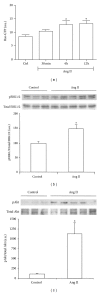Effect of angiotensin II and small GTPase Ras signaling pathway inhibition on early renal changes in a murine model of obstructive nephropathy
- PMID: 25101263
- PMCID: PMC4101960
- DOI: 10.1155/2014/124902
Effect of angiotensin II and small GTPase Ras signaling pathway inhibition on early renal changes in a murine model of obstructive nephropathy
Abstract
Tubulointerstitial fibrosis is a major feature of chronic kidney disease. Unilateral ureteral obstruction (UUO) in rodents leads to the development of renal tubulointerstitial fibrosis consistent with histopathological changes observed in advanced chronic kidney disease in humans. The purpose of this study was to assess the effect of inhibiting angiotensin II receptors or Ras activation on early renal fibrotic changes induced by UUO. Animals either received angiotensin II or underwent UUO. UUO animals received either losartan, atorvastatin, and farnesyl transferase inhibitor (FTI) L-744,832, or chaetomellic acid A (ChA). Levels of activated Ras, phospho-ERK1/2, phospho-Akt, fibronectin, and α-smooth muscle actin were subsequently quantified in renal tissue by ELISA, Western blot, and/or immunohistochemistry. Our results demonstrate that administration of angiotensin II induces activation of the small GTPase Ras/Erk/Akt signaling system, suggesting an involvement of angiotensin II in the early obstruction-induced activation of renal Ras. Furthermore, upstream inhibition of Ras signalling by blocking either angiotensin AT1 type receptor or by inhibiting Ras prenylation (atorvastatin, FTI o ChA) reduced the activation of the Ras/Erk/Akt signaling system and decreased the early fibrotic response in the obstructed kidney. This study points out that pharmacological inhibition of Ras activation may hold promise as a future strategy in the prevention of renal fibrosis.
Figures








Similar articles
-
Angiotensin AT(1) receptor inhibition-induced apoptosis by RhoA GTPase activation and pERK1/2 signaling pathways in neonatal obstructive nephropathy.Histol Histopathol. 2012 Jul;27(7):919-30. doi: 10.14670/HH-27.919. Histol Histopathol. 2012. PMID: 22648547
-
Anti-renal fibrosis effect of asperulosidic acid via TGF-β1/smad2/smad3 and NF-κB signaling pathways in a rat model of unilateral ureteral obstruction.Phytomedicine. 2019 Feb;53:274-285. doi: 10.1016/j.phymed.2018.09.009. Epub 2018 Sep 5. Phytomedicine. 2019. PMID: 30668407
-
Targeted genomic disruption of H-ras and N-ras has no effect on early renal changes after unilateral ureteral ligation.World J Urol. 2009 Dec;27(6):787-97. doi: 10.1007/s00345-009-0399-8. World J Urol. 2009. PMID: 19288266
-
[Pathophysiology and clinical implication of obstructive nephropathy].Nihon Hinyokika Gakkai Zasshi. 2003 Nov;94(7):645-55. doi: 10.5980/jpnjurol1989.94.645. Nihon Hinyokika Gakkai Zasshi. 2003. PMID: 14671994 Review. Japanese.
-
Obstructive nephropathy and renal fibrosis.Am J Physiol Renal Physiol. 2002 Nov;283(5):F861-75. doi: 10.1152/ajprenal.00362.2001. Am J Physiol Renal Physiol. 2002. PMID: 12372761 Review.
Cited by
-
Dissecting the Involvement of Ras GTPases in Kidney Fibrosis.Genes (Basel). 2021 May 24;12(6):800. doi: 10.3390/genes12060800. Genes (Basel). 2021. PMID: 34073961 Free PMC article. Review.
-
Genome-wide Profiling of Urinary Extracellular Vesicle microRNAs Associated With Diabetic Nephropathy in Type 1 Diabetes.Kidney Int Rep. 2017 Dec 1;3(3):555-572. doi: 10.1016/j.ekir.2017.11.019. eCollection 2018 May. Kidney Int Rep. 2017. PMID: 29854963 Free PMC article.
-
Pathophysiological Mechanisms of Renal Fibrosis: A Review of Animal Models and Therapeutic Strategies.In Vivo. 2017 Jan 2;31(1):1-22. doi: 10.21873/invivo.11019. In Vivo. 2017. PMID: 28064215 Free PMC article. Review.
-
The Effects of Long-Term Chaetomellic Acid A Administration on Renal Function and Oxidative Stress in a Rat Model of Renal Mass Reduction.Biomed Res Int. 2017;2017:5125980. doi: 10.1155/2017/5125980. Epub 2017 Feb 23. Biomed Res Int. 2017. PMID: 28326323 Free PMC article.
-
The molecular biology of pelvi-ureteric junction obstruction.Pediatr Nephrol. 2018 Apr;33(4):553-571. doi: 10.1007/s00467-017-3629-0. Epub 2017 Mar 13. Pediatr Nephrol. 2018. PMID: 28286898 Free PMC article. Review.
References
-
- Ucero AC, Benito-Martin A, Izquierdo MC, et al. Unilateral ureteral obstruction: beyond obstruction. International Urology and Nephrology. 2014;46(4):765–776. - PubMed
-
- Klahr S, Ishidoya S, Morrissey J. Role of angiotensin II in the tubulointerstitial fibrosis of obstructive nephropathy. American Journal of Kidney Diseases. 1995;26(1):141–146. - PubMed
-
- Pimentel JL, Jr., Montero A, Wang S, Yosipiv I, El-Dahr S, Martinez-Maldonado M. Sequential changes in renal expression of renin-angiotensin system genes in acute unilateral ureteral obstruction. Kidney International. 1995;48(4):1247–1253. - PubMed
-
- Pimentel JL, Jr., Sundell CL, Wang S, Kopp JB, Montero Á, Martínez-Maldonado M. Role of angiotensin II in the expression and regulation of transforming growth factor-β in obstructive nephropathy. Kidney International. 1995;48(4):1233–1246. - PubMed
Publication types
MeSH terms
Substances
LinkOut - more resources
Full Text Sources
Other Literature Sources
Medical
Research Materials
Miscellaneous

